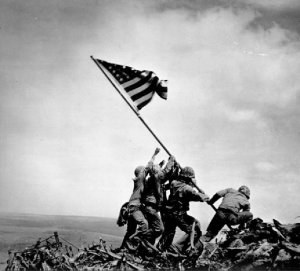COUNTDOWN TO ROAD TO TOKYO: DEATH AT JAPAN’S DOORSTEP
As we continue down the Road to Tokyo, we stop next at the Death At Japan’s Doorstep gallery, which will detail the Battles for Iwo Jima and Okinawa. These battles were the final two island D-Days for the American military before the invasion of Japan itself – and two of the bloodiest battles in the Pacific Theater of World War II. Death at Japan’s Doorstep will examine these events in detail, covering their strategic importance as well as conveying the incredible experiences of those who fought. Exhibits will include Iwo Jima and Okinawa.
Iwo Jima
On February 19, 1945, the U.S. Marine Corps invaded Iwo Jima. The Japanese Forces were determined to fight to the death rather than surrender. Nearly 7,000 U.S. Marines were killed and 20,000 were wounded over 36 days of combat. Most of the 20,000 Japanese soldiers who fought were killed in action – only a few hundred lived to surrender. Maps and diagrams in the exhibit will be used to show the logistics of the invasion and the underground defensive network of caves and tunnels used by the Japanese. Artifacts and oral histories will help convey the experiences of individual marines. The exhibit will also cover the service of Navajo code talkers, who created a highly secure code based on their unique language. The code talkers sped up battlefield communications which saved lives and greatly contributed to an American victory. Securing Iwo Jima was strategically significant because it eliminated an important base used by Japan, but the battle is ultimately remembered for the exemplary service and extreme sacrifice of the Marine Corps. Twenty-seven Medals of Honor were awarded for action on Iwo Jima, which is more than any other battle in U.S. history.

Flag-raising on Mount Suribachi, Iwo Jima on February 23, 1945. Courtesy of The National Archives and Records Administration.
Okinawa
The invasion of Okinawa on April 1, 1945 was the largest amphibious landing in the Pacific Theater of World War II and the last island battle before the invasion of mainland Japan. The initial landing was unopposed, but the Japanese Forces put up a fierce defense from caves, pillboxes, and other strong points as American soldiers and marines moved inland. Fighting at sea was equally brutal. The exhibit will examine the kamikaze tactics of the Japanese, where suicide pilots sunk or damaged dozens of Allied vessels and inflicted more casualties on the Navy than on any other service branch in the assault. The Americans lost more men on Okinawa than in any other battle in the Pacific. More than 12,000 American soldiers, sailors, and marines were killed. The Japanese suffered even greater casualties, with more than 100,000 military personnel killed. Approximately 25 percent of the civilian population also perished.
The Okinawa exhibit will demonstrate the intensity, desperation, and violence of the battle and will also cover the devastating loss of extraordinary individuals, such as the famous war correspondent, Ernie Pyle, and General Simon B. Buckner. A deeply moving and educational exhibit, Okinawa will urge visitors to consider the high costs of war.
The Okinawa and USS Franklin narrative film within Death at Japan’s Doorstep has been made possible through a generous gift by Jennifer and Phil Satre.
- Posted :
- Post Category :
- Tags :
- Follow responses to this entry through the RSS 2.0 feed. You can skip to the end and leave a response. Pinging is currently not allowed.





Leave a Reply